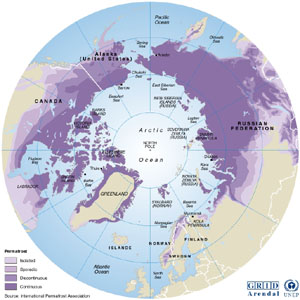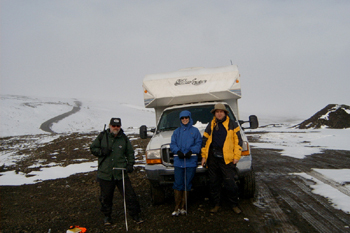|
10:20 a.m., March 21, 2003--Geocryology, or the study of permafrost, is an increasingly important area of study in the larger field of global change science, Frederick E. Nelson, professor of geography at the University of Delaware, writes in the March 14 issue of Science magazine.
 Nelson, who has undertaken extensive field studies of permafrost in the Arctic, notes in an article titled “(Un)frozen in Time” that geocryology got off to a rocky start in 1838 when a Russian academician told the Royal Geographical Society of London that the ground in central Siberia was frozen to a depth of more than 100 meters. The claim was met with disbelief. Nelson, who has undertaken extensive field studies of permafrost in the Arctic, notes in an article titled “(Un)frozen in Time” that geocryology got off to a rocky start in 1838 when a Russian academician told the Royal Geographical Society of London that the ground in central Siberia was frozen to a depth of more than 100 meters. The claim was met with disbelief.
It was not until the next century, after the Soviet Union had gained extensive experience with construction on frozen ground, that geocryology was developed as an integrative discipline with links to geography, geology, engineering, hydrology and ecology.
Nelson writes that geocryology emerged as an important component of climate change studies in the 1990s “because the distribution, thickness, temperature and stability of permafrost are determined to a large extent by the temperature at Earth’s surface.”
He adds that permafrost, which is defined as any subsurface materials that remain at or below freezing continuously for two or more years, plays three important roles in climate-change science. First, because it preserves a record of temperature changes at Earth’s surface, permafrost acts as a data archive. Precise measurements taken in deep boreholes show that permafrost temperatures have increased markedly during the latter half of the 20th century in the northernmost regions of North America and Eurasia, and Nelson writes, “This trend appears to be accelerating.”
Permafrost's second role is to translate the effects of climate change by impacting natural ecosystems and human infrastructure. Changes have been most dramatic in regions where permafrost is relatively thin and its geographic distribution is “patchy.” Extensive areas in central Alaska have experienced thaw subsidence over the past two centuries, converting birch forests to low-lying wetlands. Heated structures built on ice-rich terrain are subject to thaw-induced settlement or collapse unless specialized engineering design criteria are used.
 |
| Frederick Nelson (left), head of the University of Delaware Permafrost Group, with UD doctoral student Anna Klene and Research Associate Kolia Shikomanov near Imnavait Creek on Alaska's North Slope in mid-August 2002. |
One of the biggest challenges facing geocryologists is separating out changes induced by climate warming from those caused by localized human activities, Nelson writes. If climate warming exceeds design criteria, extensive damage to infrastructure could result. There have been many reports of thawing ice-rich permafrost causing damage to structures over the past decade. More than 300 buildings in the vicinity of Fairbanks, Alaska, have been affected by thawing permafrost, although most problems can be traced to inadequate site preparation or design flaws. Permafrost is an increasingly important consideration for planners, mortgage lenders and the real estate industry.
The third role of permafrost is to facilitate further climate change. Substantial amounts of organic carbon are stored in the upper layers of permafrost. If a widespread increase in the depth of annual thaw occurred much of this carbon could escape to the atmosphere as carbon dioxide and methane, leading to intensified climate warming.
Nelson writes that the permafrost regions occupy about one-quarter of Earth’s terrestrial surface, with perennially frozen ground underlying extensive areas in both polar regions and at higher elevations in mountains of the middle latitudes. New research is being conducted on submarine permafrost around the margins of the Arctic Ocean.
Information obtained by geocryologists could have important implications beyond Earth. Nelson writes that “knowledge about landforms created by growth and ablation of ground ice may help in the quest for exploitable water resources on Mars.”
Nelson leads the University of Delaware Permafrost Group (UDPG), a subunit of the Department of Geography. UDPG hosted the first workshop of the Circumpolar Active Layer Monitoring (CALM) program in November 2002 at the Virden Center on UD’s Lewes campus. Thirty-five scientists from six nations attended the workshop, which was funded by the National Science Foundation's Arctic System Science program.
An important event for geocryologists occurs every five years, when the International Permafrost Association holds a large scientific meeting. The eighth such conference will be held in July in Zurich, Switzerland. The role of permafrost in climate change science will be a central focus of this gathering of several hundred permafrost scientists from around the world.
Article by Neil Thomas
|

